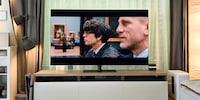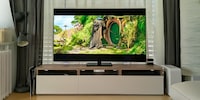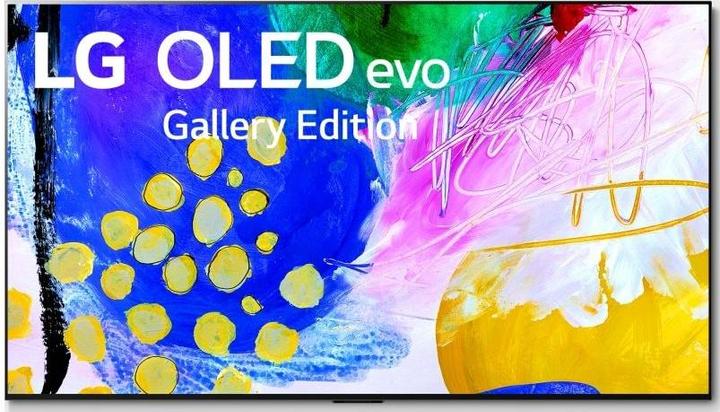

LG's best OLED TV in the test: Is it still enough for the top position?
For a long time, LG dominated the high-end TV market with OLED. Since Samsung's newly released QD OLED technology, however, there is real competition for the first time: LG has to admit defeat - even if only by a narrow margin.
It has looked better for the South Korean tech giant LG. This is due to the unusually strong competition: when Samsung announced at the beginning of the year that it would launch its first marketable OLED TV, it was tantamount to a moderate earthquake. Namely, Samsung would bring an evolution of its proven OLED technology, QD-OLED, and Sony would jump right in and buy panels from Samsung.
In fact, the QD-OLED TVs that have been available since the summer know how to excite. This could shift the balance of power in the organic LED market, which has been dominated by LG until now. LG itself did not remain idle, however. In 2021, the so-called Evo panels were introduced, but only for the expensive G series. Since 2022, the more economical C series has also benefited from the improved Evo panel. Nevertheless, to set the G series apart, LG has given it an additional heat sink that dissipates the heat of the Evo panel more efficiently. This is how the G-series is supposed to achieve a higher peak brightness.
Full Disclosure: The TV, the 77-inch version of the G2, was provided to me by LG for testing.
Design: Nothing new in the East
Actually, the G2 belongs on the wall, like a picture in a gallery. The "G" stands for "gallery" design. Accordingly, the TV's architecture: instead of having an ultra-thin panel at the top, as usual, which practically consists only of OLED layers, while the thick bulge for hardware and connections comes at the bottom, LG's G2 is uniformly thick - no matter where you measure it. In numbers: two centimetres.
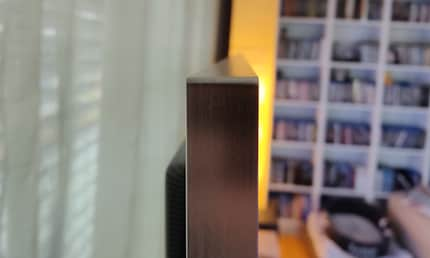
Source: Luca Fontana.
The only problem is if you want to put the TV in front of a window, as I do at home. Fortunately, there's a remedy for this in the form of separately available stands. Cost: about 200 francs. Problem solved. There is then a little more than five centimetres between the lower edge of the TV and the TV furniture. This can be a problem with some soundbars - such as Sony's HT-A7000, which I recently tested: If the infrared sensor for the remote control is covered, switching the TV on and off becomes a cramp.
.
Other than that, LG remains true to its Gallery design: modern, slim, narrow edges - no frills at all. The TV is held together by an elegant aluminium frame at the front and a less elegant plastic cover plate at the back, which covers the connections and helps with cable routing. Nothing out of the ordinary, then. Fits like a glove. Not every TV has to look like an "I" in serif font when viewed from the side. I'm looking at you, Samsung.
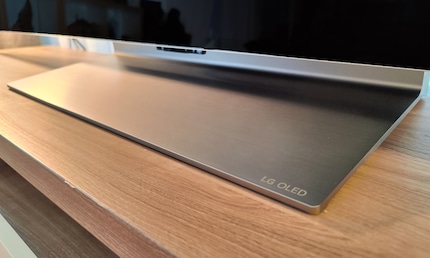
Source: Luca Fontana.
Onto the specs. LG's G2 offers the following:
- 4x HDMI 2.1 ports (4K120Hz, ALLM, FreeSync Premium Pro and HDMI Forum VRR)
- One of them with eARC (HDMI 2)
- 3x USB 2.0 port
- 1x output for Toslink
- 1x LAN port
- 1x CI slot
- Antenna ports
- Bluetooth 5.0
- Compatible with Apple AirPlay 2, Apple HomeKit, Google Home and Amazon Echo
All four HDMI inputs support HLG, HDR10 and Dolby Vision. Only HDR10+ is missing. A pity, even if its distribution is very small anyway: until today, I have only seen isolated HDR10+ content on Amazon Prime Video. The lack of a pass-through function for DTS audio signals is much more serious. If you want to watch a UHD Blu-ray with a DTS soundtrack, for example, the signal is converted into a lower-quality PCM signal. Dolby Atmos, on the other hand, is looped through without a problem.
One more word about the weight. The television weighs 35.1 kilograms. With the stand, the TV weighs 41.7 kilograms. But again, a TV stand is NOT included in the delivery. Since the G2 is designed for wall mounting, a narrow wall bracket is included for this purpose.
Measurements: The LG G2 can keep up with Samsung's QD OLED - just barely
What comes next goes deep into the matter. If tables and diagrams don't interest you, you can skip all that and scroll straight to the chapter "The picture: OLED-worthy reference material - but with a slight green cast". From there on, you'll get my subjective impressions with lots of video footage.
Of course, I could just show filmed or photographed displays and point out strengths and weaknesses. Ultimately, however, I would only be reflecting my subjective perception. How bright, natural and true to colour a television really is can also be measured in figures. That has one advantage: numbers are more objective than I am.
To bring you this new service - so far, it's available in my reviews of Samsung's 2022 Neo QLED (QN95B), Sony's 2022 QD-OLED (A95K), Samsung's 2022 QD-OLED (S95B) and TCL's 2022 mini-LED (C93) - we've been looking at professional tools acquired from Portrait Displays.
I measured out all the screen modes of the TV. From "Standard" to "Cinema" to "Dolby Vision Cinema Home", without calibration or manual changes in the settings. Just like most normal people use a television. After all, you want to know whether a TV is accurate and true to colour without expensive and professional calibration. I only switched off the sensors for automatic brightness. Nobody needs them and they distort the measurements anyway.
.
The best values for all types of content - except for gaming, for which you should always use the game mode - were achieved with the "Dolby Vision Cinema Home" mode. The measurements below therefore always refer to this mode.
The maximum brightness
The brightness is important for the TV for two reasons. On the one hand, it affects the contrast value and thus how many different colours a TV can display. On the other hand, brightness is important if you often watch TV in rooms flooded with light. If a TV is not bright enough, it can be outshone by the ambient light in the room. The picture will then look rather pale to you.
LG claims to have made great progress in precisely this area: Thanks to improved algorithms and a new chemical composition with deuterium, the second-generation Evo panel is said to have become more heat-resistant. In addition, there is the additional heat sink of the G series. The panel can therefore absorb even more energy without becoming hotter than its predecessor. This is important: too much heat increases the burn-in risk. The extra power, in turn, makes for an even brighter picture. LG even talks of 30 per cent more brightness compared to its previous OLED panels. Unfortunately, I can't check this because I didn't have my own measuring equipment last year. Next year then...
Apropos: LG also sells the Evo panel to its competitors. But there it is called "OLED.EX" because LG wants to lease the "Evo" brand for itself. Internally, i.e. between the C and G series, LG's marketing does not distinguish between Evo with and Evo without additional heat sinks. Summa summarum: The main thing is complicated.
So, let's now look at the brightness of the G2. In the graph, I compare directly with Samsung's S95B and Sony's A95K, both of which source QD OLED panels from Samsung's factories. The latter are said to be brighter than LG's OLED Evo panels. Nevertheless, LG should not be completely without a chance with the new Evo panel.
There are two axes: the vertical stands for brightness, the horizontal for the section in which the brightness is measured. At two percent of the entire screen area, i.e. selectively and with very small image areas, LG's G2 achieves a very good overall value of 958 nit. As expected, however, it can't quite match Samsung's and Sony's QD OLED TVs, whether at a very small or at the full window size - the subjectively perceived overall brightness.
.
Nevertheless: the difference is actually not great. In fact, I would argue that it is hardly noticeable even if all three TVs were right next to each other.
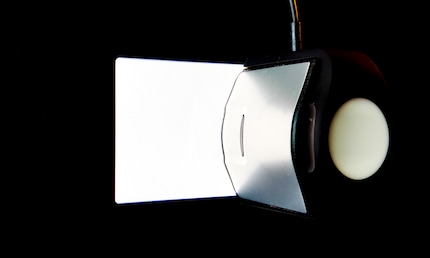
Source: Luca Fontana
To put it in perspective, LCD TVs emit at around 650-700 nit at full window size due to the technology. In bright rooms with dark scenes, they therefore have an advantage over OLED and QD OLED. In dark rooms, on the other hand, the latter two panels come up trumps, especially in colour reproduction. That's why OLED and especially QD OLED TVs are still considered the measure of all things.
The white balance
What exactly does white look like? That depends on the colour temperature. On the warmth or coldness of white. Warm tends towards yellow/orange. Cold tends towards blue. This in turn affects the representation of colours. In the industry, a white with 6500 Kelvin has been agreed upon for calibration, in short: white point D65. Most people would perceive this as a warm white, just like the resulting colours. Then the various "Dolby Vision" or "Cinema" modes of most manufacturers are calibrated. The white and colours in "standard" mode, on the other hand, are much colder. For this reason alone, "standard" mode does not produce a reference-worthy image.
White is created on the TV when the red, green and blue subpixels per pixel radiate simultaneously and with equal intensity. The full brightness therefore produces the brightest white. The lowest brightness, on the other hand, produces the deepest black. If the subpixels can even switch off completely, as with OLED or QD-OLED, we talk about real black. Everything in between is therefore nothing more than shades of grey. The accuracy of the white balance is therefore measured with two tables:
- Grey scale delta E (dE)
- RGB balance
The greyscale dE shows how much the greyscale produced by the TV deviates from the reference value. The RGB balance shows in which direction the greyscales produced by the TV deviate from the reference value. Why is this important? Let's take a look at the concrete G2 example:
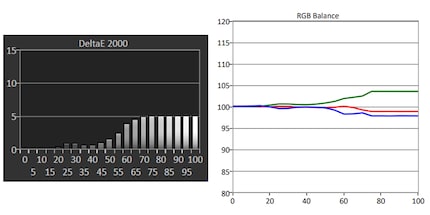
Source: Luca Fontana
If you were to place the TV directly next to a reference monitor, this would mean:
- Value is 5 or higher: most people can tell the difference from the reference monitor.
- Value between 3 and 5: Only experts and enthusiasts recognise the difference.
- Value between 1 and 3: Only experts recognise the difference, enthusiasts do not.
- Value below 1: Even female experts do not recognise the difference.
Any value below five is a very good value for a non-calibrated TV. So far, almost no TV I've tested has managed this consistently, not even Sony's QD OLED TV. LG's G2, however, only exceeds the 5 limit at about 70% brightness, and that only minimally. On average, the average dE is 2.19 dE (dE Avg). This is the best value I have measured so far; previously it belonged to Samsung's S95B with an average dE of 2.35. Samsung's QD OLED TV never crosses the 5 mark on the chart for this.
.
A look at the RGB balance now shows to what extent the white balance deviates from the reference value. There, a slight green tint becomes apparent the whiter the generated white is. In other words, the green subpixels radiate a little too strongly. But as I said, the deviation is just around dE 5. It is therefore very unlikely that you will actually perceive the green cast as such in a real image. Especially without a reference as a comparison. Excellent marks, then, for LG's G2.
The colour gamut
To continue with the colour gamut, the coverage of the most common colour spaces: the greater the contrast, the more colours can be displayed and the more natural the picture looks. This is why the gamut is important for HDR content, as it uses large colour spaces with its eponymous high dynamic range.
- Rec. 709: 16.7 million colours, standard colour space for SDR content such as live TV and Blu-Rays
- DCI-P3 uv: 1.07 billion colours, standard colour space for HDR content, from HDR10 to Dolby Vision
- Rec. 2020 / BT.2020 uv: 69 billion colours, hardly used in the film and series industry yet
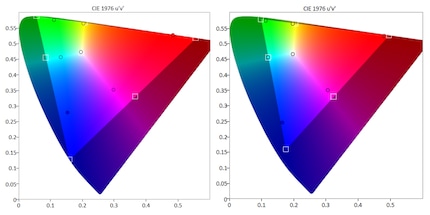
Source: Luca Fontana
The large "colour blob", including the darkened areas, shows the full range of colours detectable by the human eye. The lightened area on the left shows the BT.2020 colour space. On the right, the same, simply the smaller DCI-P3 colour space. The white boxes show the actual boundaries of the respective colour spaces. The black circles, on the other hand, show the limits actually measured during measurement.
The measurement resulted in the following colour space coverage:
- Rec. 709: 100% (good = 100%)
- DCI-P3 uv: 99.18% (good = >90%)
- Rec. 2020 / BT.2020 uv: 75.43% (good = >90%)
The G2 achieves an excellent 99.18 per cent coverage in the important DCI-P3 colour space. This easily outperforms TCL's Mini-LED and Samsung's Neo-QLED TVs: TCL achieved "only" 86.11 per cent. Only Samsung's and Sony's QD OLED TVs have so far achieved a whopping 100% coverage in the DCI-P3 colour space.
On the BT.2020 colour space. LG's G2 covers this with "only" 75.43 per cent. That's much better than TCL's mini-LED - and marginally better than Samsung's Neo QLED. Still, I would have expected a better score from an OLED TV, closer to 80 per cent coverage.
"Why not 90 per cent?" you may ask.
As of today, only QD OLED TVs manage the targeted 90 per cent coverage for the BT.2020 colour space, and just barely. This is precisely why the film and series industry calibrates its HDR content almost exclusively in the much more widespread DCI-P3 colour space. The BT.2020 colour space is considered more of a colour space of the future; the extent of its coverage is more an indicator of the future viability of the TV.
Much more important, therefore, is the colour error.
The colour error
For the television set, colours are not colours, but numbers. Numbers that precisely define the colours within a given colour space. For example, fire red. Ivy green. Or cadet blue. When you watch television, these numbers are sent to your television as metadata. It interprets the data and displays them as corresponding colours. Simple. Or?
No. TVs can indeed process and display most signals within the most common colour spaces. But that does not mean that they will accurately represent the colours. Otherwise, the picture would look exactly the same on all televisions. Therefore, the more the colours displayed correspond to those on reference monitors, the more true to colour and the better the TV.
As with the greyscales above, the deviation of the TV from the reference value is referred to as dE. The white boxes show the reference colours sent to the TV by the test pattern generator. The black circles, on the other hand, show the colours actually measured. Again, dE values below 5 are good for non-calibrated TVs.
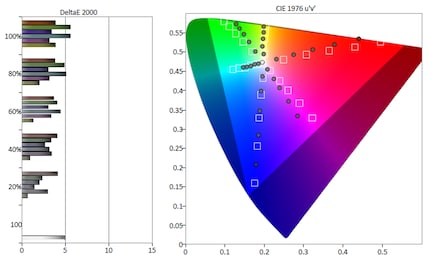
Source: Luca Fontana
The graph clearly shows: LG's G2 already has good colour fidelity with Dolby Vision content by default. In fact, with a total of 40 measured values, I measured an average dE of a good 3.34. However, LG does not come close to the QD OLED TVs from Sony and Samsung: with an average dE of 2.64 and 2.46 respectively, they push the error value below three. LG's G2 doesn't manage this, and even ranks behind Samsung's Neo QLED, which positively surprised me with a dE Avg of 2.97 in the test back then.
For comparison: In standard mode, the average dE was a miserable 15.28. Only Samsung's Neo QLED looks worse in standard mode with its 19.24. Unfortunately, the conventional cinema mode, which I always activate for non-Dolby Vision content, is also disappointing. There, the average dE was 9.54. This is far too high for that mode, which is often praised as the "reference" mode by manufacturers outside of "Dolby Vision" content.
Reflections
Per se, reflections on the screen are not measurable. However, some of you have written to me wishing that I would address them in my tests anyway. Good idea. To test this, I will recreate a normal situation in the living room: a photo during the day, without closed curtains, blinds or shutters. Behind me the oven, next to the TV the floor lamp. The light from the floor lamp is reflected by the glass of the oven behind me and thrown back onto the TV.
.
And here is the result:
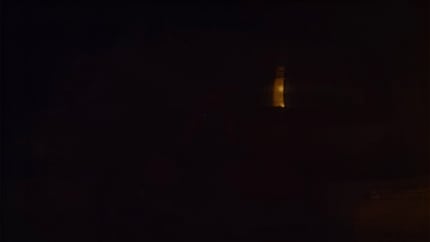
Source: Luca Fontana
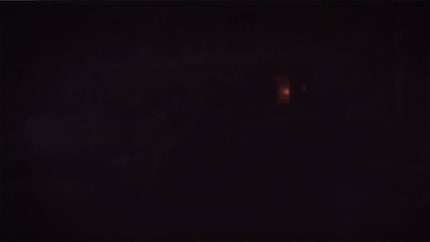
Source: Luca Fontana
LG's G2 copes with direct reflections slightly less well than Samsung's S95B. Especially in the evening, the lamp can be annoying when watching TV, even though I found the reflections on the C93 from the Chinese manufacturer TCL much more disturbing. During the day, however, reflections can be a problem. But this is more due to the TV's technology-related lower brightness than to the anti-reflective coating.
Intermediate conclusion after measurement
Let's draw a brief interim conclusion. Those who feared half a year ago that Samsung and Sony would easily outperform LG with their QD OLED panels can breathe a sigh of relief (I'm thinking mainly of LG's executive suite): The G2 does well, shines almost as brightly as the QD OLED competition and even beats them in white balance. In addition, LG loses in the coverage of the most common colour spaces and the colour error, as expected, but only by a small margin. Only the "Cinema" mode is disappointing: while its colour accuracy is always very good with other manufacturers, it is unsatisfactory with LG.
The picture: OLED-worthy reference material - but with a slight green cast
Bright picture. Good colour with Dolby Vision. Less so with rest of HDR content. Theoretically. How does it look in practice?
Colour reproduction
When I want to test a TV for its colour reproduction, I turn to "Guardians of the Galaxy, Vol. 2". This scene in particular: Ego's golden palace pops in saturated evening red. In it, Drax's greenish skin full of blood-red tattoos, looking razor sharp. Compared to the QD OLED competition from Sony and Samsung, however, LG's scene has a slight green cast, which was already announced above in the white balance test. At least wherever red, orange or yellow dominate as a colour. Nothing wild, though. Without direct comparison, this would hardly be noticeable. To my taste, LG's picture even looks more natural as a result - even if the director's intention here was obviously to capture the kitschy Golden Hours of the planet more than to ensure a natural picture. Perhaps the best compromise comes from Samsung's Neo QLED with mini-LED technology at the end of the video.
Let's shift down a few gears. Colours don't always have to pop in the picture. For instance, in "James Bond - Skyfall", when James and the young quartermaster Q look at the picture of a proud old battleship being ignominiously towed to the scrapyard in an art museum. An allusion to the ageing secret agent, of course. As yet, I only have comparative material for this scene from Samsung's and TCL's mini-LED TVs. Nevertheless, the result is interesting. Here you can see the difference between Dolby Vision and conventional HDR. This is because Samsung is one of the few TV manufacturers that does not have a Dolby Vision licence. The comparison shows: Dolby Vision has significantly more "punch" in the picture.
The lack of Dolby Vision format is still one of Samsung's few major weaknesses: LG's and TCL's Dolby Vision images look pleasantly warm, powerful and yet natural. In the direct comparison between LG and TCL, I tend to favour the South Korean TV on the left; the Chinese TV on the right seems a touch too contrasty.
Black Crush and Shadow Details
Not all scenes are bright. Some are really dark. That's why I want to test LG's ability to show details in dark areas of the picture. I give the G2 a run for its money in this regard. I first compare it with the QD OLED competition from Samsung and Sony, then with TCL's LCD TV with mini-LED backlight. I expect the latter to be weaker in comparison. There is a reason for this: each OLED pixel emits its own light. At the same time, each OLED pixel can be switched off with pinpoint accuracy. LCD pixels cannot do either. That's why only (QD) OLED TVs are capable of perfect black, also called True Black.
For this test, the first scene from "Blade Runner 2049" comes to mind. LG's, Samsung's and Sony's (QD) OLED TVs are wonderfully dark and, above all, natural. If you film against the light, it is normal that the rest disappears in black silhouettes. That's why there is no question of black crush - details that are swallowed up by the darkness. With LG, however, the green tint is clearly visible; Samsung's and Sony's picture appears much warmer and therefore more accurate. On the other hand, the image of LG's G2 is much less noisy, which you can see very well in the tiles from minute 3:45.
Compared with TCL's mini-LED TV, you can see what I mean by LG's "wonderfully dark" OLED picture: TCL's picture is far too bright and brings out details where there shouldn't be any. This is due to the technology-related brightness of the LCD picture: a blessing compared to OLED in a bright room during the day, but a curse in a darkened room during dark scenes. In addition, there is strong blooming, a kind of halo around bright objects in front of a dark background. Watch out for windows, for example.
Brightness gradations
A final image test: Brightness gradations. Due to the technology, LCD TVs in particular flex their muscles here. Actually. In the following "Jurassic World" example, pay attention to the sun in the background: none of the TVs in the video has a clear advantage over the others; it is clearly visible everywhere as a sphere in the firmament. It is interesting, however, that of all things, a non-LCD panel like Sony's QD OLED panel handles the bright picture material best; to me, it seems brighter and yet more natural than its competitors. Especially when I pay attention to the skin tones.
Processor: At the usual strong level
The processor is the brain of the television. Its main task is to receive, process and display picture signals. Processing means that it recognises poor picture quality and upgrades it. LG puts it this way: "The intelligent processor analyses and optimises nuances and contrast in real time, ensuring more clearly discernible details in every scene."
Behind all the sensational marketing gobbledygook is that the processor is supposed to remove noise, enhance colours, smooth edges, make motion smoother and add any missing pixel information.
Motion Processing and Judder
To start with, I make it really hard for the processor. Specifically: Judder, a phenomenon that all TVs have. Judder occurs when the picture signal and the TV panel do not have the same frame rate. With cinema films, for example. LG's G2 can display up to 120 frames per second. But films are shot at 24 frames per second. Processors synchronise this disparity with interframe calculations. If the processor is too aggressive, the picture looks as exaggeratedly fluid as in a soap opera à la "Good Times, Bad Times". But if it holds back, the picture stutters. Especially during long camera pans. The film seems nervous - in English: jittery. The word "judder" has somehow been derived from this.
Sam Mendes' "1917" is full of such steady, slow-flowing camera movements and thus perfect for the judder test. When comparing it to other producers, pay particular attention to whether the vertical bars in the barn move smoothly through the frame or stutter.
This year, LG's Alpha 9 processor, now in its fifth generation, shows what it's made of: if I set the "Clarity" setting to "Natural Picture", there is hardly a trace of judder to be seen. The Japanese manufacturer Sony, on the other hand, hardly intervenes in the judder reduction. A film, according to Sony's thinking, has to jolt. Just like in the cinema before the digital age. Beautifully old-fashioned. Or old-fashioned beautiful? For me, at least, it's too much jerking.
In the second comparison, Samsung's OLED Neural Quantum processor comes into play. I filmed the image there in Filmmaker mode. By default, it has the Judder reduction completely switched off. After I turned it up from "0" to "7", judder is visible if you pay attention to it, but it is never obtrusive. Compared to LG, it's even more fluent. I like that. TCL's processor in the last comparison unfortunately doesn't stand a chance in this respect - it stutters and jerks tremendously.
Next scene from "1917". Here, too, Mendes' camera work provides an immense challenge for most processors. Especially with hard edges against blurred backgrounds, for example around the helmets of the two soldiers. There, both the processor and the pixels have to react incredibly quickly.
LG's Alpha 9 and Samsung's Neural Quantum processor don't show any weakness here either. Sony's processor again lags a little behind, though not as much as TCL's processor. Especially compared to the latter, the (QD) OLED panels are in a league above: the perfect black gives the picture that extra punch and adds depth to the scene.
Pixel response time
Next up, the Apple original "For All Mankind". I want to see how long a single pixel takes to change colour. If it doesn't happen fast enough, it looks to you like the image is streaking - the effect is called "ghosting". When the camera pans over the surface of the moon, pay attention to the text in the bottom left-hand corner.
None of the TVs show any weaknesses here. At most, LG shows a little ghosting at the beginning. But that is hardly noticeable: good marks. Especially for TCL. Because it is difficult for LCD TVs to show this scene free of streaks. OLED TVs, on the other hand, have excellent response times due to the technology. That's why they are also considered excellent gaming monitors. LCD TVs are at a disadvantage on that point.
Upscaling
Now for one of the most difficult tests: upscaling. I want to see how well the processor upscales lower quality sources. Blu-rays or good old live TV, for example. Or "The Walking Dead". The series was deliberately shot on 16mm film to create the feeling of a broken, post-apocalyptic world with old-fashioned grain, complete with image noise.
Here, too, LG cuts a fine figure as usual. Usual, because I've also found LG's processors to be particularly good at upgrading inferior sources in years past. Because that one up there is an HD source with SDR quality, whose approximately 2 million pixels are blown up to 8.3 million pixels. Sony's processor in the first comparison does manage a little more image sharpness. But LG has almost no compression artefacts and much less noise: stop the video at minute 00:05 and look for the dark area between the two men to see what I mean.
Samsung's Neural Quantum processor in the second comparison does the best job in this scene: the picture is sharply drawn, pleasantly warm, rich and yet natural. In addition, there is almost no picture noise. Only in terms of compression artefacts do I see LG slightly ahead. TCL's processor, on the other hand, comes off worst: The picture is far too bright - as if it had been shot in studio light and not in the dark forest - and has almost no punch.
Gaming: Input Lag and Game Mode
Once again this year, LG wants its OLED TV to be positioned as the best gaming TV on the market. In general, LG has always wanted to make itself popular with gamers. This is demonstrated by the LG OLED Flex, a TV that curves at the touch of a button, which will be released in the next few weeks.
Colleague Samuel has already tested it. As soon as the TV is available for order, his test will also go online. But back to the LG G2. Is the TV also suitable for gaming this year? Absolutely. When I measured the colour accuracy in "Game Mode", I came up with an average Delta E of 9.02 (see "Colour Error" above if you're interested in the details). This is not a reference picture level. But I don't expect that in "Game Mode" either. Game modes reduce unnecessary image enhancement metadata for all manufacturers. This reduces the processing time and consequently the input lag on the TV - at the expense of picture quality. I have already written about this here.
For comparison: in "Standard Mode" LG's G2 comes to a Delta E of 15.28. That's lousy: the lower the Delta E, the better. In my tests, only TCL's Game mode beat the targeted Delta E limit of 5; so when it comes to colour accuracy in gaming, no one can beat the Chinese, not even LG.
On the input lag, I measured an average input lag of a very good 10.4 milliseconds with a UHD picture at 60 frames per second using the measuring device from Leo Bodnar. Furthermore, the TV supports all features relevant for gamers:
- 4x HDMI 2.1 ports (4K120Hz)
- Auto Low Latency Mode (ALLM)
- Variable frame rates (Nvidia G-Sync, AMD Freesync Premium and HDMI Forum VRR)
To this end, LG - just like Samsung, Sony, Philips, TCL and Panasonic - has entered into a partnership with many major gaming studios. The result: HGiG - HDR Gaming Interest Group. According to the manufacturer, this should ensure that HDR is displayed as the game developers intended. For example, when playing "Spider-Man: Miles Morales" on my Playstation 5.
In comparison with TCL, it quickly becomes clear which of the two TVs conjures up the more accurate colours. On the other hand, with LG I notice that black is really black, the edges look sharp and the picture doesn't blur even when the camera pans quickly and jerkily. Look at Miles' dark silhouette against the light, the detailed textures of snowy New York or the clearly visible details in the clouds. This is what a good game mode looks like.
Nice: Like last year, LG again offers a dedicated submenu where you can make fine adjustments for gaming and read the current frame rate. Very important: LG's G2 supports the new VRR 120Hz mode of the PS5 without any problems.
Smart OS: webOS
LG relies on webOS, which was completely overhauled in 2021.Since then it has looked a lot like the old version of Google TV - not to my delight. The old webOS was sleek and slim. Pressing the Home button only opened an app bar at the bottom of the screen. Now a whole window full of tiles opens. This looks full and cluttered.
Google had the problem too. But since last year's clean-up, its operating system is much tidier. LG does the opposite. There are three big tiles at the top. Weather on the left, tips in the middle about what the new TV can do (thanks?), and a search app on the right. Below that is a line with suggested content. Actually, content from all the streaming apps I use should appear there. However, only Disney+ content is displayed, which has nothing whatsoever to do with what I usually watch on Disney+.
Then comes the app.
Then comes the app bar. The most important bar. It is now the smallest bar. From here on, I have to scroll down. This does feel fluid and responsive - thanks to a good processor. But it's just as unsexy as the muddle of tiles that show me connected devices, the Smart Home hub and who-knows-what-else. It's a mess as far as the eye can see. I'm still not a fan of it.
Conclusion: Not nearly enough for the top spot
When I first reported on Samsung's upcoming QD OLED panels earlier this year, I feared the worst for LG: the Quantum Dots assisted organic LEDs (hence the "Q" in "QD-OLED") seemed to do everything LG's conventional OLEDs could do much better. Especially in terms of brightness and colour saturation.
I was not wrong in this assessment. However, Samsung's lead is not quite as big as I initially thought: with its second-generation OLED Evo panel, LG once again gets everything out of a technology that has produced the best picture quality on the market for a good six years. This is due to the further optimised chemical composition of the Evo panel and the additional heat sink, which LG only grants to the G series. In one category, LG even trumps its QD OLED competition in the measurements, the white balance, and in the other measurements it only just falls short. I consider that a great success.
If I had to choose one of the above-mentioned TV flagships today, I would tend to go for Samsung's S95B with QD-OLED panel. It doesn't cost much more than that anyway. Sony's A95K, however, does. With Samsung or Sony, the only big question mark that remains is which teething problems have yet to be discovered and will only surface as the years go by.
My tip is therefore a TV that I have so far only mentioned in passing because I have not yet been able to test it myself: LG's OLED C2. First, because it costs almost a thousand francs less than the G-series. Secondly, because I've always found the C-series I've tested in the past to be excellent. And thirdly, because that's precisely why I can't imagine that the picture of the C-series is significantly less good only because of the missing G2 heat sink.
Titelfoto: Luca Fontana
I write about technology as if it were cinema, and about films as if they were real life. Between bits and blockbusters, I’m after stories that move people, not just generate clicks. And yes – sometimes I listen to film scores louder than I probably should.



